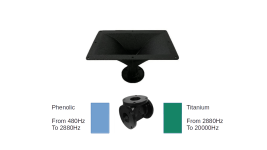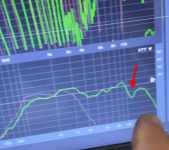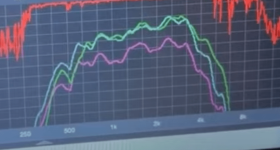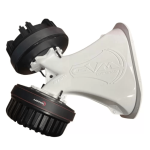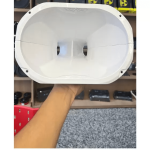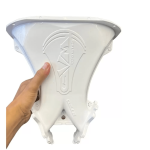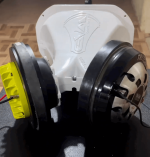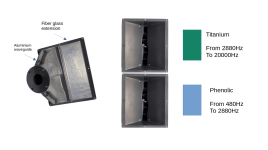Hello,
Regarding dual driver adapter and horn, do you guys have any experience coupling Phenolic and Titanium Driver at the same flange adapter? see attached image.
The most common application is to match two drivers from the same type (twin) as we can see in the link below where the author was investigating if the flange adapter in fact deliver +6dB for dual driver. Unfortunately this gain was not true because in his findings the flange changes the impedance coupling for the driver resulting to only +2dB. I'm not find many information about dual drivers on the web.
https://www.prosoundtraining.com/2010/05/26/manifold-drivers/
I do not want to go twin drivers running the same frequency range, but instead to have 1 Phenolic driver and 1 Titanium covering different frequency ranges but using only one horn to have single point source and avoid cancellations, the other benefit is to reduce space with a single compact box. Additionally, I'm thinking about using passive crossover between those two driver so they could share the same amplifier.
What do you guys think about pros and cons?
MID-HIGH : from 480Hz to ~2880Hz ==> Driver JBL D405 Phenolic
HIGH : from ~2880Hz to 20000Hz ==> Driver Snake SD375 Titanium
This box could deliver 110dB @2,83V/1m from 480Hz to 20000Hz
1/4 WL for 480Hz is 17,7cm so the horn don't need to big very long.
Regards
Regarding dual driver adapter and horn, do you guys have any experience coupling Phenolic and Titanium Driver at the same flange adapter? see attached image.
The most common application is to match two drivers from the same type (twin) as we can see in the link below where the author was investigating if the flange adapter in fact deliver +6dB for dual driver. Unfortunately this gain was not true because in his findings the flange changes the impedance coupling for the driver resulting to only +2dB. I'm not find many information about dual drivers on the web.
https://www.prosoundtraining.com/2010/05/26/manifold-drivers/
I do not want to go twin drivers running the same frequency range, but instead to have 1 Phenolic driver and 1 Titanium covering different frequency ranges but using only one horn to have single point source and avoid cancellations, the other benefit is to reduce space with a single compact box. Additionally, I'm thinking about using passive crossover between those two driver so they could share the same amplifier.
What do you guys think about pros and cons?
MID-HIGH : from 480Hz to ~2880Hz ==> Driver JBL D405 Phenolic
HIGH : from ~2880Hz to 20000Hz ==> Driver Snake SD375 Titanium
This box could deliver 110dB @2,83V/1m from 480Hz to 20000Hz
1/4 WL for 480Hz is 17,7cm so the horn don't need to big very long.
Regards
Attachments
Cons:
The manifold messes up the frequency response of the HF (deep notch around 10kHz followed by a peak above) also reducing HF output compared to the straight adapter.

Having tried (and sold..) the Electro Voice dual manifold adapter which is probably the best design around, can't recommend it.
It is telling that EV stopped using it and created dual straight entrance horns in the later versions of the MTH4.
At any rate, with both BMS and B&C (DCX 354, DCX464, DCX462) making co-axial drivers that have as much (or more) LF output as a 4" phenolic and cleaner high end than any driver going through a manifold adapter, I'd follow Electro Voice and use the B&C drivers like they do in the current MTS series 👍 .

B&C also sells passive crossovers for their co-ax drivers, a design time saver.

Art
The manifold messes up the frequency response of the HF (deep notch around 10kHz followed by a peak above) also reducing HF output compared to the straight adapter.
Having tried (and sold..) the Electro Voice dual manifold adapter which is probably the best design around, can't recommend it.
It is telling that EV stopped using it and created dual straight entrance horns in the later versions of the MTH4.
At any rate, with both BMS and B&C (DCX 354, DCX464, DCX462) making co-axial drivers that have as much (or more) LF output as a 4" phenolic and cleaner high end than any driver going through a manifold adapter, I'd follow Electro Voice and use the B&C drivers like they do in the current MTS series 👍 .
B&C also sells passive crossovers for their co-ax drivers, a design time saver.
Art
Last edited:
dual straight entrance horns in the later versions of the MTH4
Hello weltersys, thanks for sharing your experience.
The dual straight entrance horns looks interesting and could be a nice solution too. This horn is still on selling at USA?
Those BMS and B&C driver were already expensive before covid, and now, they aren't an option for non professional people like me.
I already have 2 Titanium drivers 2", so looking for some possible upgrades for fun and for sound quality. Drivers are very sensitivity and are very slow space consuming. Lowering the frequency response from them to 500Hz open space to replace my Bass Reflex 10" with a kick bin 12" from 120hz to 500Hz. Keeping Titanium covering from 1800Hz and up would require the kick bin 12" + another woofer like 6" to bridge the gap witch would increase too much the space and costs to reach the same SPL.
Find a way to make those two driver working together would be preferable and cheap.
Thanks also to post FB4648 for crossover, it will be part of the solution.
I just found the videos below from someone that build dual horn Phenolic + Titanium, you guys can check. International music at time 1:32. But unfortunately he recorded the audio from cellphone. He had an RTA microphone and a notebook in place but didn't provided any objective measurement.
Triton TRD 505 -> Phenolic (silver one)
Eros ETD 722500 -> Titanium (Yellow one)
He was using the aluminium horn GVM 2750 as you can see attached picture. Checking the website it doesn't look to have good engineering behind. Don't know, he looks happy with the results.
There is 2 others videos where the user compare the dual-horn (twin) vs double simple horn with objective measurements but from 500Hz to 5000Hz range as in the attached image #4 and #5, so it doesn't help much once we can't check the issues at 10kHz an up as pointed from @weltersys
There was a 4th video, short one, where at the beginning he was pointing that people should not using different spare parts for dome otherwise it could be and issue to sum the response it was a twin driver. At the time 0:58 he starts to show Phenolic + Titanium combination with objective measurement as you can see in the attached image #5 witch confirms the dip around 10kHz frequency as pointed from @weltersys but no issue up, maybe because the measurement was using too much smooth. The results doesn't look bad.
Note: The videos are in Portuguese and musics aren't the best ones but they can be useful.
Triton TRD 505 -> Phenolic (silver one)
Eros ETD 722500 -> Titanium (Yellow one)
He was using the aluminium horn GVM 2750 as you can see attached picture. Checking the website it doesn't look to have good engineering behind. Don't know, he looks happy with the results.
There is 2 others videos where the user compare the dual-horn (twin) vs double simple horn with objective measurements but from 500Hz to 5000Hz range as in the attached image #4 and #5, so it doesn't help much once we can't check the issues at 10kHz an up as pointed from @weltersys
There was a 4th video, short one, where at the beginning he was pointing that people should not using different spare parts for dome otherwise it could be and issue to sum the response it was a twin driver. At the time 0:58 he starts to show Phenolic + Titanium combination with objective measurement as you can see in the attached image #5 witch confirms the dip around 10kHz frequency as pointed from @weltersys but no issue up, maybe because the measurement was using too much smooth. The results doesn't look bad.
Note: The videos are in Portuguese and musics aren't the best ones but they can be useful.
Attachments
I can't speak about the dual in same horn aspect, but I used JBL2482 Phenolic 4" diaphragm / 2" throat drivers on a mid freq horn pair and JBL2435Be drivers on upper mid horns
Worked very well.
To this day I still use the same 2482s on 200Hz horns and Vitavox S2s (fully reburbed by Vitavox with latest diaphragms), currently on 550Hz Le Cléac'h horns.
So marrying something to Phenolic is no problem for me.
The rich tonal quality, detail and punch of the Phenolic's I still find amazing.
The S2s used the right way are my end game upper mid drivers.
Worked very well.
To this day I still use the same 2482s on 200Hz horns and Vitavox S2s (fully reburbed by Vitavox with latest diaphragms), currently on 550Hz Le Cléac'h horns.
So marrying something to Phenolic is no problem for me.
The rich tonal quality, detail and punch of the Phenolic's I still find amazing.
The S2s used the right way are my end game upper mid drivers.
It works only with identical drivers producing identical (within reason) wavefront, like this:dual straight entrance horns looks interesting and could be a nice solution too.
https://josephcrowe.com/blogs/news/2094
As soon as you add crossover and mount different drivers, they are presented with a huge discontinuity at the end of the manifold. For two-way horn you need something like Synergy, where injection port is small and do not disturb HF driver wavefront that much, or - hardly feasible for simple DIY - mechanoacoustical filters like in PK Sound Coherent Midrange Integrator or in BMS coaxial compression drivers. Simply feeding a horn with two disparate drivers won't bring great results.
But you can try anyway, if only to see will it be that bad.
Did you noticed any comb filtering due to the distance between those two horns? probably the frequency range where frequency is lower then the center distance between those two horns might present cancellations. Did you add delay or you was able to physically align those two horns? maybe twose two horns have the same length and it was not an issue. If you could share image of the system.I can't speak about the dual in same horn aspect, but I used JBL2482 Phenolic 4" diaphragm / 2" throat drivers on a mid freq horn pair and JBL2435Be drivers on upper mid horns
Worked very well.
The rich tonal quality, detail and punch of the Phenolic's I still find amazing.
Yes, i like it too and with the advantage of high SPL for a PA down to 500Hz with compact volume.
For two-way horn you need something like Synergy, where injection port is small and do not disturb HF driver wavefront that much, or - hardly feasible for simple DIY - mechanoacoustical filters like in PK Sound Coherent Midrange Integrator or in BMS coaxial compression drivers. Simply feeding a horn with two disparate drivers won't bring great results.
To minimize the issues you point, maybe another option would be to use "two line array wave guides" for the drivers as attached image. There is one wave guide made of aluminium with an extension made of fiber glass longer enough (27cm) for the frequency range. It may narrow the vertical dispersion but it might be a good compromises minimizing the cancellation due to wave guides. High frequencies are narrow anyway.
Attachments
Dual entry horns have big problems in the HF. They aren't worth the trouble IMO. A good coax would serve you better. The DCX50 is a nice driver, but being 2" exit makes the HF a little wiggly - not too bad though.
I've always time aligned since having DSP. Measuring mic at the listening position.Did you noticed any comb filtering due to the distance between those two horns? probably the frequency range where frequency is lower then the center distance between those two horns might present cancellations. Did you add delay or you was able to physically align those two horns? maybe twose two horns have the same length and it was not an issue. If you could share image of the system.
Yes, i like it too and with the advantage of high SPL for a PA down to 500Hz with compact volume.
Recently I brought the 3 horn mouths level with each other, time aligned as usual, but then also added the delay the length of each respective horn gives.
This have a noticeably more cohesive sound.
I also tried it with the driver diaphragms near physically aligned, time aligning in DSP and adding the horn lengths, I liked this too over normal diaphragm alignment, but prefer the mouths aligned physically as well.
Being 5 way, each horn is not doing a wide frequency, well below 3 octaves.
I did try BMS 4592ND 2" Coaxial Neo drivers 3.5" and 1.75"
on the 200Hz horn.
Was not as good as my two separate horns covering the same frequency range.
Perhaps different horns needed?
I sitt more than 14ft away from the mouths, but didn't notice problems sitting a bit nearer. Less bass / mid bass punch when nearer though.
I've also changed the mid horn front mount to behind the horn mouth. Can't say that change made any acoustic change.
Looks better though🙂
And angled the outer mid horn in a bit more. Gave more presence.
Last edited:
A good coax would serve you better. The DCX50 is a nice driver,
Coaxial are too expensive right now too be considered as an option :/
Being 5 way, each horn is not doing a wide frequency, well below 3 octaves.
Congratulations for your system, it's a beautiful and for sure sounds amazing.
Based on your system, maybe, having one horn for Phenolic and other horn for Titanium might not be a big issue as I thought. At the end there is no perfect system and we always end deciding about the trade-offs.
What slope and frequency are you using at crossover point between Phenolic and Titanium?
==================================================================================================================
Current cons summary:
- Coaxial Horn -> More expensive option. Lowest volume.
- Dual-horn/adapter -> Dip at 10kHz and probably more dips and peaks up to 20kHz. Low volume.
- Two Wave-guides -> Narrow vertical dispersion and minimal cancellation. Intermediate volume. (There are some taller wave-guides that may help)
- Two Single Horns -> Max Cancellations from Comb-filtering. Max volume.
The HPD42 dual-throat constant-directivity, TransPlanar™ horns used in the MTH-4.5/42B as far as I know were not sold as separate units, and probably were not sold much after 1996.The dual straight entrance horns looks interesting and could be a nice solution too. This horn is still on selling at USA?
I already have 2 Titanium drivers 2", so looking for some possible upgrades for fun and for sound quality.
Lowering the frequency response from them to 500Hz open space to replace my Bass Reflex 10" with a kick bin 12" from 120hz to 500Hz.
Find a way to make those two driver working together would be preferable and cheap.
Thanks also to post FB4648 for crossover, it will be part of the solution.
The HPD42 horns are too small to be consant directivity as low as you want to go.
Having done both for PA, I think making your mid bass cabinet to cover from around 120Hz-1200Hz and running your 2" titanium drivers 1200Hz and up would sound far better than a phenolic midrange barking like a mad dog from 500 to 1800 Hz.
Art
I use 2nd order L-R for the phenolic JBL 2482 mids - 300 and 750Hz.Coaxial are too expensive right now too be considered as an option :/
Congratulations for your system, it's a beautiful and for sure sounds amazing.
Based on your system, maybe, having one horn for Phenolic and other horn for Titanium might not be a big issue as I thought. At the end there is no perfect system and we always end deciding about the trade-offs.
What slope and frequency are you using at crossover point between Phenolic and Titanium?
The Vitavox S2s are not Titanium or Beryllium - not sure what they are but they are the latest and best... Apparently 🙂
Aluminium and composite surround I think, but not sure.
They are crossed in with a simple 3uF capacitor. This gives a 1st order coming in around 1100 - 1200Hz.
The 1st order allows as much S2 low freq loveliness in as possible. The 3uF cap completely removes the Freq bump these drivers have at 1KHz (1KHz from memory..).
Just get a nice smooth slope ramping up.
Measuring the 2 together gives a nice flat Freq resp.
I was crossing the phenolic's higher before but listening and measuring saw that drop to current 750Hz.
Having done both for PA, I think making your mid bass cabinet to cover from around 120Hz-1200Hz and running your 2" titanium drivers 1200Hz and up would sound far better than a phenolic midrange barking like a mad dog from 500 to 1800 Hz.
Once I'm hobbist and don't have much experience, didn't listening too many different set up, and you have a lot of experience, your suggestion has much more weight then mine so I will think about. Could you give more detail why you saying the phenolic would "barking like a mad dog"?
High order kick-bin may not cover all the frequency range you suggest, to cover it with bass flex at the same SPL level I may need dual 12" or even more drivers to reach similar SPL level and also much more volume. The Phenolic has the same SPL as titanium so it should be guaranteed flat from 500Hz to 20kHz.
Hmm, in the bad old days phenolic was only good to ~3 kHz in public address (original 'PA') horn apps until Altec developed the Symbiotik as a high power alum. variant good to ~12.5 kHz before dropping like a stone for modern PA apps, so curious what kind of phenolic will do 'guaranteed flat from 500Hz to 20kHz'?
I tried my system as a 4 way a few years ago, just to see / hear.
I set the JBL2482s to play up to 3KHz or 3.5KHz and then my Raal Lazy ribbons took over from there to their high freq limit.
The Raals will play down to 3KHz cleanly, if not over driven.
In domestic settings, no compression driver is "barking like a mad dog"! Yes in a PA setting I can believe it, but not in domestic with quality drivers and the right horns and crossovers.
We are just tickling these very high power, high efficiency compression drivers in hifi rooms.
They can sound absolutely stunning!
The 4 way test sounded pretty good actually, particularly on rock music.
If that had been all I'd ever heard, I would have been quite happy I think.
But having heard the Vitavox S2 loveliness, especially on the upper vocal range, violins, acoustic etc, it is so magical, I have stayed with 5 way every since.
Here's a pic of the 4 way test set up

Here's the 5 way. Note the tapped horns behind the stack in these pics

DSP delays the front horns etc by some 12ms give or take, to time align.
I did not align the mouths physically back then or add horn path length to the delay.
I was using 550Hz tractrix on upper mids back then.
The larger 550Hz Le Cléac'h are even smoother.
I set the JBL2482s to play up to 3KHz or 3.5KHz and then my Raal Lazy ribbons took over from there to their high freq limit.
The Raals will play down to 3KHz cleanly, if not over driven.
In domestic settings, no compression driver is "barking like a mad dog"! Yes in a PA setting I can believe it, but not in domestic with quality drivers and the right horns and crossovers.
We are just tickling these very high power, high efficiency compression drivers in hifi rooms.
They can sound absolutely stunning!
The 4 way test sounded pretty good actually, particularly on rock music.
If that had been all I'd ever heard, I would have been quite happy I think.
But having heard the Vitavox S2 loveliness, especially on the upper vocal range, violins, acoustic etc, it is so magical, I have stayed with 5 way every since.
Here's a pic of the 4 way test set up
Here's the 5 way. Note the tapped horns behind the stack in these pics
DSP delays the front horns etc by some 12ms give or take, to time align.
I did not align the mouths physically back then or add horn path length to the delay.
I was using 550Hz tractrix on upper mids back then.
The larger 550Hz Le Cléac'h are even smoother.
Last edited:
phenolic will do 'guaranteed flat from 500Hz to 20kHz'?
Not Phenolic alone from 500Hz to 20kHz, this range would be covered from Phenolic combined to Titanium as mentioned. So Phenolic from 500Hz to 3kHz and Titanium from 3kHz to 200kHz. Both capable, considering datasheet information, to deliver 110dB/2,83v/1m, so, flat response in the range from 500Hz to 20kHz.
But weltersys suggests to not use phenolic but instead use box with woofer in the range from 500Hz to 1,2kHz and set Titanium from 1,2kHz and bove.
For home stereo levels, the excursion limitations of the 4" diaphragm won't be a problem at 500 Hz, for PA use they may be, depending on the horns chosen and the levels you want.
Note that the HL4750-SLF horn used for the D405 specifications is only 40x20 degrees, rather narrow for a single horn and is 108dB/2,83v/1m at 500Hz.
Note that the HL4750-SLF horn used for the D405 specifications is only 40x20 degrees, rather narrow for a single horn and is 108dB/2,83v/1m at 500Hz.
For home stereo levels, the excursion limitations of the 4" diaphragm won't be a problem at 500 Hz, for PA use they may be, depending on the horns chosen and the levels you want.
I will try to run some simulation for a kick-bin and see what I can achieve as frequency response, but in general, high order to achieve higher SPL don't provide much more then 2 octaves sometime, if I get more bandwidth we can increase the crossover from 500Hz to 700Hz probably, let see. I'm little slow currently yo run simulations due to free time.
Note that the HL4750-SLF horn used for the D405 specifications is only 40x20 degrees, rather narrow for a single horn and is 108dB/2,83v/1m at 500Hz.
True, too narrow, but in terms of output SPL, even changing Horn to improve dispersion, no direct radiator loudspeaker design can achieve the same SPL level for the same given voltage.
- Home
- Loudspeakers
- Multi-Way
- Dual 2" Driver - Is the Phenolic + Titanium a good combo?
